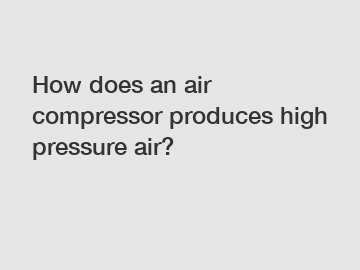Dec. 18, 2023
Machinery
How does an air compressor produce high-pressure air?
Air compressors are indispensable tools used in a wide range of industries for various applications. They are designed to convert power, typically from an electric motor or engine, into potential energy stored in compressed air. By compressing the air, an air compressor can generate high-pressure air, producing a constant supply of air for tasks such as powering pneumatic tools or machinery. In this article, we will explore the process of how an air compressor produces high-pressure air.
Basic Operation:

Before diving into the details, it's important to understand the fundamental principles of how an air compressor works. At its core, an air compressor operates through a series of events that involve drawing in air, compressing it, and then discharging it at a higher pressure. The compressor accomplishes this through a mechanical process that utilizes pistons, rotating screws, or vanes to compress the air.
Primary Compression Stage:
The primary compression stage is where air compression begins. In a reciprocating piston compressor, the piston moves downwards, creating a low-pressure area inside the cylinder. This low-pressure atmosphere causes atmospheric air to flow into the cylinder through an intake valve. As the piston moves back upwards, it compresses the air, reducing its volume and increasing its pressure. Simultaneously, another valve called the discharge valve is closed, preventing the compressed air from flowing back into the cylinder.
Secondary Compression Stage:
In certain air compressor designs, a secondary compression stage is employed to achieve even higher pressures. This stage involves compressing already compressed air received from the primary compression stage further. It can employ a similar mechanism as the primary stage or utilize different methods such as screw compressors or rotary vane compressors.
Further reading:Screw Compressors:
One commonly used type of air compressor, the screw compressor, employs two interlocking helical screws, called rotors, to compress air. As the rotors rotate, air enters the chamber, and the mechanical interaction between the screws and the chamber walls compresses the air. As the screws continue to rotate, the compressed air is expelled at a higher pressure, often assisted by an external cooling mechanism.
Rotary Vane Compressors:
Rotary vane compressors consist of a rotor with slots on its periphery and vanes that slide inside the slots. As the rotor spins, the vanes are pushed outwards by centrifugal force, creating larger compartments. Air is drawn into these compartments through the intake valve, and as the rotor rotates, the vanes slide back, reducing the compartment size and compressing the air. Finally, the air is discharged at a higher pressure.
Closing Paragraph:
In conclusion, air compressors produce high-pressure air through a series of stages that involve drawing in air from the surrounding environment, compressing it, and discharging it at a higher pressure. Whether through reciprocating pistons, screw compressors, or rotary vane compressors, these devices play a vital role in various industries. If you have any further questions about how air compressors work or if you need assistance selecting the right type of compressor for your needs, please do not hesitate to contact us.
Contact Us: .
If you have any inquiries regarding air compressors or need further assistance, please feel free to contact us at [Contact Details]. We are here to help!
For more china gx cs4 compressor company, gx-e-cs4, china gx-pump supplierinformation, please contact us. We will provide professional answers.
Further reading:Previous: The Ultimate Guide to Induction Quenching Machines
Next: Can ozone generators revolutionize sustainable irrigation?
Related Articles
If you are interested in sending in a Guest Blogger Submission,welcome to write for us!
All Comments ( 0 )